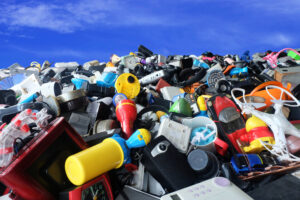
Plastic-eating, silk-producing bacteria could be a new ally in the fight against waste
Canadian Plastics
Research & Development SustainabilityResearchers in New York are genetically engineering a microorganism that “eats” petroleum-based plastic waste and converts it to a biodegradable plastic alternative.

Photo Credit: damrong/Adobe Stock
Each year tens of millions of tons of plastic are sent to landfills, while another 8 million metric tons of plastic end up in the ocean. A better solution is to break down the waste for reuse, but determining how to do this effectively and efficiently has been a persistent challenge.
With the support of a new National Science Foundation grant, a team of engineers from Rensselaer Polytechnic Institute in Troy, N.Y. will explore a potentially transformative idea: genetically engineering a microorganism that “eats” petroleum-based plastic waste and converts it to a biodegradable plastic alternative.
“We have all of this plastic pollution in the environment that comes from all of this plastic that we use on a daily basis, most of which is based on petroleum feedstocks, which are based on molecules that can’t degrade naturally in the environment,” said Helen Zha, an assistant professor of chemical and biological engineering at Rensselaer, who is leading this research project.
Zha and her collaborators will explore whether a genetically engineered bacteria would be capable of breaking down petroleum-based plastic waste that could then be used as energy to produce artificial silk, a biodegradable protein that can behave much like traditional plastic.
“The use of metabolic engineering approaches for plastic waste degradation and its conversion to higher value chemicals such as biopolymers is an underexplored area of research,” said Mattheos Koffas, a professor of chemical and biological engineering who has previously established a number of microbially-based processes and now joins Zha in this research. “Our collaborative effort will provide more sustainable and environmentally friendly methods and materials.”
A current barrier to using silk as a replacement for traditional plastic, Zha said, is that it’s hard to produce from nature in large quantities. Designing and creating a new bacteria that can manufacture artificial silk could be a valuable solution.
“At some point, we as a society should be transitioning to using plastics that not only come from non-petroleum-based sources, but can also be completely degraded into something that goes into the natural environment,” Zha said.
“How to optimize the molecular architecture and microstructure of artificial silk is a fascinating design problem that nature has perfected over hundreds of millions of years, yet we have just started to piece clues together,” said Yunfeng Shi, an associate professor of materials science and engineering, and another collaborator on this grant.
This unique challenge requires a cross-disciplinary approach, bringing engineers together from across departments – and the Rensselaer team is also partnering with Guohong Mao, the associate director of Conagen, a bio-synthesis and bio-manufacturing company.
Source: Rensselaer Polytechnic Institute
